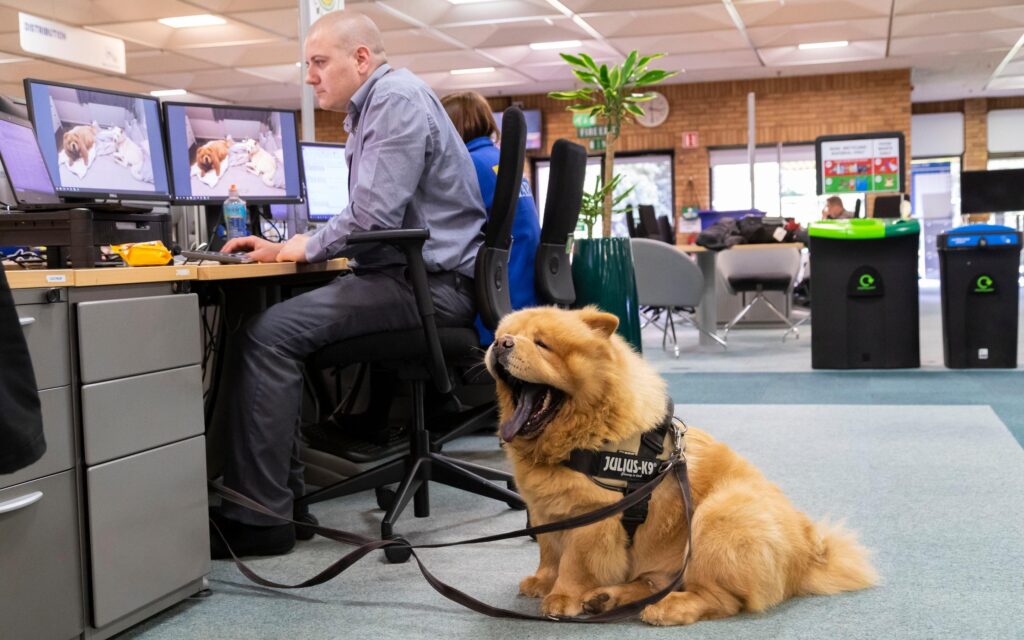I don’t know about you, but I get tired of humans. Sure, they’re (allegedly) sentient and all that, but sometimes you just want a simple interaction with no complications. At times like that, nothing can beat the zest and energy of a little canine companion.
But dogs at home are one thing — what about office dogs? Sure enough, as more and more employers make efforts to be amenable and friendly to attract young, bright millennial employees, dogs are an increasingly common sight in the workplace. I myself worked for a firm in Italy that had a disabled dog, hooked up to some rear wheels he would zoom around like some mad race driver. The wheels were actually quite loud, so I wouldn’t officially recommend a handicapped office dog, but what about our non-disabled canine friends?
Like a big, furry stress ball

Several studies have shown that the presence of dogs is known to reduce stress in nearby workers. Cortisol (the stress hormone) levels of people cohabiting their office space with a dog were reportedly lower than those in an all-human workplace.
So, is having an office dog a one-way ticket to improving your work environment? A way of giving employees a pleasant, relaxing outlet when work becomes hectic or tiresome? No one can deny that a dog’s happy energy is contagious. One study even showed that the presence of a dog caused people to be 30% more trusting of one another than when no dog was present. Perhaps these dogs are master therapists, weaving ancient incantations to soothe our troubled minds.
Whatever the case, a canine companion is an effective way of increasing productivity in your team. It’s a way for employees to destress and refresh their minds, enabling them to return to work with renewed zeal. In the office setting, workers remain all-too-often glued to chairs and hunched over screens, falling into a sedentary regime that is good for neither body or mind. Ross Pike of Koreti comments, ‘One of the biggest threats to wellbeing in office life is inactivity. Having a happy, animated dog around the workplace stirs activity and acts as a ward against inertia.’ Those employees that want to get away from their desks for a brief moment can interact with the pup, and those in need of some more energy-consuming exercise can take the dog out for a midday walk.
Pet peeves

But, shock and horror — not everyone likes dogs. Especially for a small business, bringing in a dog when one or more employees are ill-disposed toward them (or worse, allergic), may do far more harm than good. True enough, there are valid, practical reasons why dogs can sometimes trigger employee irritation. Loud noises, such as lorries driving past or alarms sounding can convince the dog that the world is ending, and rapidly so that the best course of action is to start barking as loudly as possible. This is especially troublesome for those who are engaged in work calls and have to apologize for the canine’s behavior. What’s more, bringing in clients or new faces can incur great excitement in a dog, causing yet more unwanted ruckus. So, the proper homework should be done before soliciting canine assistance to make sure everyone’s on board.
Fuzzy burglars

Assuming there are no dissenters, there are still issues that can arise. If you work for a smaller business, and you’re having a sandwich at your desk while reading through a spreadsheet, it may be the last thing you want to have to fend off a very determined, hungry four-legged thief with no understanding of the concept of personal property (or perhaps a radically progressive socialist dog that vehemently disagrees with any notion of private ownership).
At the Nestlé headquarters near Gatwick, where dogs have been introduced as part of the PAW (Pets at Work) program, dogs are not allowed in eating areas, to grant colleagues a safe haven where their food is not at risk of burglary. But a smaller business may not be able to cordon off zones to unauthorized canine personnel. In this case, it may be worthwhile ensuring that the young tail-wagger is well-trained in the art of not irritating people (something many of us bipedal folk has yet to learn).
Moving forward — the necessary steps

Let’s say you decide to go for it. What are the appropriate measures to take to avoid social (or, heaven forbid, legal) ramifications?
- First, learning the behavioral profile of the dog is paramount. Rescuing traumatized dogs is certainly a good cause, but not for an office environment. The dog should be healthy and non-aggressive. A client visiting your workplace is unlikely to be impressed by a loud, violent dog harassing nearby workers.
- Second — training. No employer wants to have to console an employee who was bitten by an overly excited dog simply trying to make a new friend. CEO Alan Jenkins of Quadrant2Design, a Bournemouth-based exhibition contractor with multiple in-house pups owned by various employees, writes, ‘Training is the deciding factor in how well a dog fits into an office. It can make the difference between having a friendly, joyous calming presence and a distracting riot of activity.’ Proper training is needed to ensure the dog will blend into the office environment without issue.
- Thirdly, there are insurance questions to consider. Hopefully, these won’t be necessary, but ultimately having an animal around increases the risk of damages to people or property. Make sure your insurance covers you and your business if any mishaps do arise.
- Fourth — pet-free areas. If possible, having a pet-free area may be valuable in case an employee ever wants a break from canine attention. Some employees, some days, may well want peace and quiet to deal with work-related issues — or just to think. A dog-free zone is useful to that end.
- Last, but certainly not least — who is the actual owner? The dog will most likely be looked after by a single employee, and they must be on board with the task of feeding, caring for, and cleaning up after the four-legged rascal. The employer must make this clear to the employee before the dog sets foot (paw) into the office.
Even with all of these precautionary measures, there is no guarantee that a dog will improve your work environment. Ultimately, work is work, and sometimes too much zest and bubbly energy can distract people away from the task at hand. Having said that, the advantages of having a well-trained dog in the office should not be overlooked. It may be just what your business needs to ramp up productivity levels and give employees another reason to look forward to going into work.
 Imagup General Magazine 2024
Imagup General Magazine 2024



